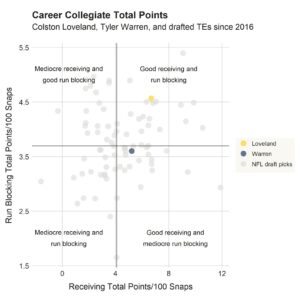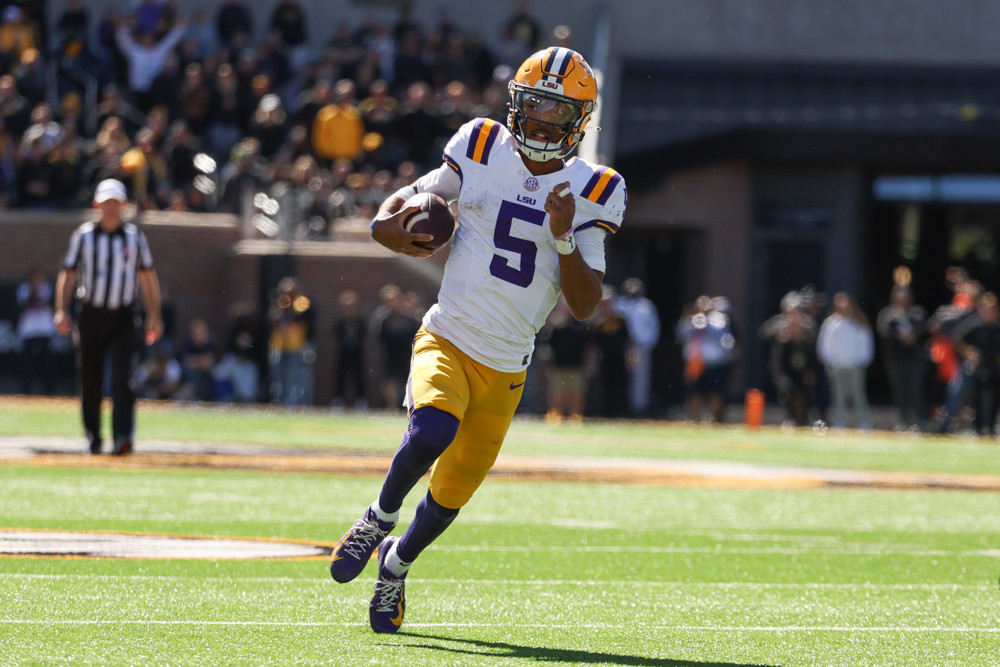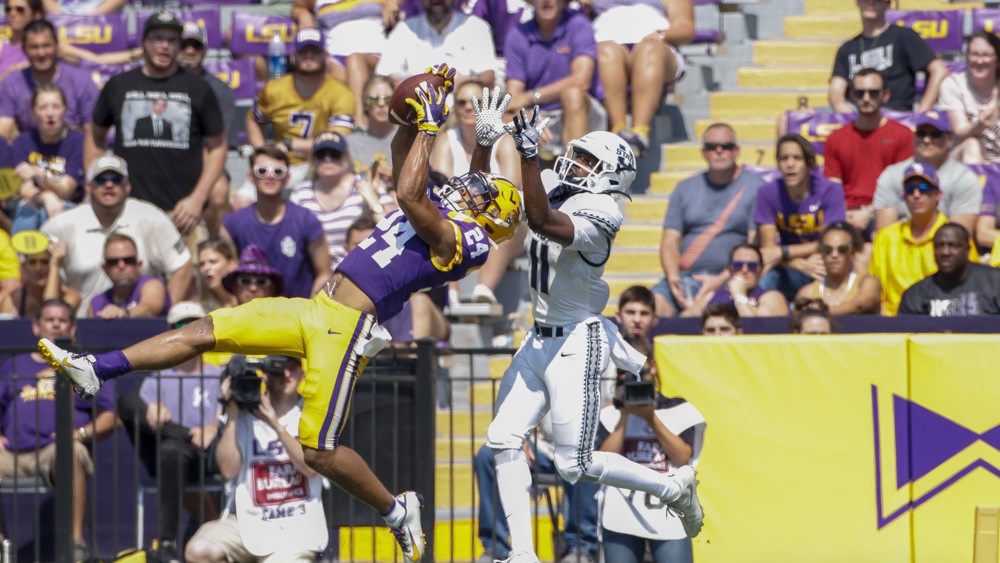Photo: Steven King (left) and David Rosenblum (right)/Icon Sportswire
It has been six years since two tight ends were last taken in the first round of the NFL Draft, when Noah Fant and TJ Hockenson went 8th and 20th overall, respectively. But that trend is likely to change this week, as Penn State’s Tyler Warren (scouting report) and Michigan’s Colston Loveland (scouting report) are both all but guaranteed to have their names called on Day 1.
These players make an interesting case study because they have similar profiles in a general sense – they’re both F tight ends – but are quite different once you dive into the particulars.
Warren is the more powerful of the two and is better with the ball in his hands, whereas Loveland is the better athlete and has true mismatch ability. Both have issues as blockers that we’ll get into.
Let’s begin with the broad strokes and take a quick look at how their teams deployed them in 2024:

As you can see, Loveland spent more time lined up as a traditional tight end, but the rates at which they moved out wide (including as an X) or into the slot were pretty similar (41% for Warren, 44% for Loveland). It’s also worth noting that the on-ball and off-ball splits are meaningfully different, particularly because they speak to the types of blocks these players were being asked to execute, which we’ll return to in a moment.
For now, let’s focus on them as receivers since their positional breakdown indicates they’re receiving threats first and foremost.
Let’s start with Warren, whose big selling point is that he’s a YAC monster. He had a 22% broken + missed tackle rate (BMT) and averaged 6.8 yards after the catch in 2024. That’s not quite Brock Bowers territory (31% BMT and 8.7 YAC in 2023), but both are top-15 marks for qualifying Power 5 tight ends (minimum 50 receptions) over the past 10+ years.
Warren does have some ability to get up the seam and did run a high percentage of vertical routes (19%), but he’s at his best working the short-to-intermediate areas of the field, with his most efficient work from a Total Points perspective coming on out-breakers and under routes (i.e. slants and drags). A middling average depth of target (ADoT) of 6.6 yards rounds out the statistical profile here, although that number is admittedly sandbagged by the fact that screens made up nearly 10% of his targets in 2024.
Loveland, on the other hand, is a better athlete and more threatening at the second and third levels of the defense. 2023 is more instructive in his case because the Wolverines were largely dysfunctional on offense in 2024 even before his season was cut short by a shoulder injury.
During Michigan’s championship season, Loveland ranked 8th among Power 5 tight ends in ADoT (9.6) and was extremely efficient on seams and fades, which made up 10% of his routes. His yards per route run of 2.6 that season was third among tight ends, trailing only Bowers and Jatavion Sanders among tight ends with 50+ targets.
Loveland has a better catch radius and body control in the air but Warren is much stronger at the catchpoint. Take a look:
Catch Percentage
| Loveland | Warren | |
| Off-Target but catchable | 63% | 47% |
| Contested but catchable | 45% | 64% |
There are some similarities, though. Both Loveland and Warren are natural hands catchers who had similar drop rates in 2024 (4.8% and 5.2%, respectively), and both are good route runners who ranked top 10 among tight ends in open rate, although Loveland is the better man separator.
As I noted atop the article: Warren is the more powerful of the two and is better with the ball in his hands, whereas Loveland is the better athlete and has true mismatch ability. The picture that’s been painted of the former thus far may make him seem more like a traditional Y, but both have shortcomings as blockers that are worth discussing.
Circling back to the point that was previously alluded to, Warren played off the ball a lot in a zone-heavy Penn State offense and was largely tasked with cutting off the back side – either by initial alignment or by splitting across – or widening out the front side of outside zone. His blocking skills require some projection considering he has mostly been responsible for generating lateral movement on zone runs and executing 2-back run game. He had a lot of good reps from a backfield alignment tracking to the second level but has seldom been a true point of attack player, with just 26 reps blocking power/duo in 2024. While he has the requisite strength and demeanor to grow into such duties and vertically displace edges at the NFL level, his length is a concern (31 ¾” arms).
Despite having the thinner frame, Loveland was base and down blocking more in Michigan’s offense, especially in 2023 under Harbaugh. He is also a willing blocker and has superior length to Warren, so the question here is not one of experience or length but of functional strength to root out NFL bodies on the edge.
It could be said that Loveland could get stronger whereas Warren’s arms will not grow anymore, but it may be difficult to accomplish the former without compromising one of his biggest selling points – his quickness and fluidity. Ultimately, both these players project better to zone schemes, albeit for different reasons. That said, most NFL teams skew zone-heavy anyway, and would be perfectly happy to settle for tight ends who are willing blockers provided they check enough boxes as receivers.
Warren and Loveland are very talented and at this point it should be clear that team fit may be more important than anything in terms of who comes off the board first. However, we can still tie this off with a general statistical comparison of Loveland and Warren to both each other and tight ends who have been drafted since 2016:

As you can see, both are pretty good receivers even in comparison to the pool of tight ends who have been drafted over the years, although interestingly enough Warren falls just below the median as a run blocker.
It should be reiterated that these players excel at different functions and therefore, that this is more of a 1A/1B situation than an exercise in picking a clear-cut better prospect. Risk tolerance likely factors in, as well, with Warren’s game feeling more familiar and therefore more bankable as a security blanket and YAC threat, whereas Loveland seems to have a higher ceiling and more game-breaking potential.
Both players are worthy of being taken in the top half of the first round, but who ends up TE1 seems like an exercise in picking your poison, and whoever lands these players will be hoping to force defenses to do just that.



